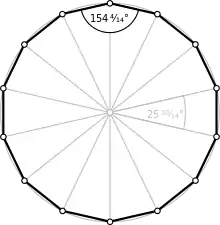Tetradecagon
A tetradecagon or 14-gon is a shape with 14 sides and 14 corners.
| Regular tetradecagon | |
|---|---|
 A regular tetradecagon | |
| Type | Regular polygon |
| Edges and vertices | 14 |
| Schläfli symbol | {14}, t{7} |
| Coxeter diagram | |
| Symmetry group | Dihedral (D14), order 2×14 |
| Internal angle (degrees) | ≈154.2857° |
| Dual polygon | Self |
| Properties | Convex, cyclic, equilateral, isogonal, isotoxal |
Regular tetradecagon
A regular tetradecagon has Schläfli symbol {14} and can be constructed as a quasiregular truncated heptagon, t{7}, which alternates two types of edges.
Dissection
Coxeter states that every parallel-sided 2m-gon can be divided into m(m-1)/2 rhombs. For the regular tetradecagon, m=7, and it can be divided into 21: 3 sets of 7 rhombs. This decomposition is based on a Petrie polygon projection of a 7-cube, with 21 of 672 faces. [1] The list A006245 defines the number of solutions as 24698, including up to 14-fold rotations and chiral forms in reflection.
 |
 |
Numismatic use
The regular tetradecagon is used as the shape of some commemorative gold and silver Malaysian coins, the number of sides representing the 14 states of the Malaysian Federation.[2]
References
- Coxeter, Mathematical recreations and Essays, Thirteenth edition, p.141
- The Numismatist, Volume 96, Issues 7-12, Page 1409, American Numismatic Association, 1983.
